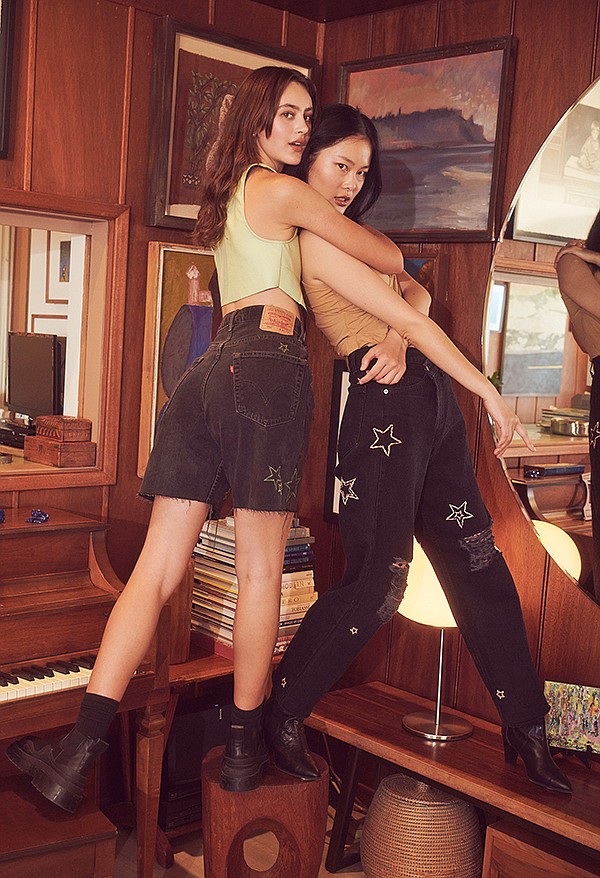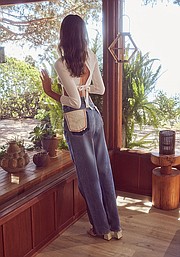Lenny creates custom and bespoke upcycled denim pieces in Los Angeles, where CEO and founder Lindsey Davidson is able to craft a story by using and repurposing jeans that have been lived in by someone else, making each piece feel a little more special and unique for the wearer.
FASHION
Lenny Combines Vintage and Upcycled for One-of-a-Kind Looks
With thrifting increasingly becoming the favored way to shop and the resale market booming as sustainability becomes a focal point of modern shoppers, vintage and upcycled clothing have been thriving as the pandemic sparked a rise in consumers shopping with their consciences as well as their wallets.
In an effort to create the perfect pair of vintage jeans, Lenny creates custom and bespoke upcycled denim pieces. The label began as a tie-dye brand at the beginning of the pandemic but quickly pivoted to a combination of founder and CEO Lindsey Davidson’s two favorite things—vintage and denim—with all Lenny products being sourced and made in Los Angeles. Davidson said she feels inspired when she sees a pair of pants and loves the silhouette, and she attempts to recreate it while also adding her own personal touches.
The brand embodies slow fashion by handcrafting each piece and doing all customizations and tailoring as well. Creating each piece individually allows Davidson to craft a story with each pair by using and repurposing jeans that have been lived in by someone else, which makes each piece feel a little more special and unique for the wearer.
“Creating each piece on a made-to-order basis allows us to put in the time and effort and also keep our brand fully sustainable and circular because when we start making a certain amount of pieces then it takes away from what our whole mission is,” Davidson said. “When you’re making large quantities you’re able to charge less and it offers accessibility for people, but a lot of times people don’t truly think about the negative impacts fashion has. They think that they wore a shirt for a season and they are done with it as opposed to thinking about the future and thinking about how it will impact the earth in 20, 30 or 40 years.”
With the Coachella Valley Music and Arts Festival kicking off this year’s season of festival fashion, many festival goers aimed to make a statement with their looks. However, the price of looking good comes at the cost of the environment in the form of additional textile waste from clothes never to be worn again. Online resale platform thredUp’srecent thredUp Festival Fashion survey reported that one in four people in the U.S. plans to attend a music festival or concert this year, with 42 percent of festival goers planning to buy a new outfit for the event. For Lenny’s Festival Fashion drop, Davidson took those realities to heart and set out to design items that not only could but would want to be worn on more than one occasion.
“So many times we shop for events but we don’t want to spend so much money and think, ‘Oh, I don’t want to spend this amount on something I’ll never wear again,’ so I felt I might as well create these timeless pieces that you can wear not just to a festival but out and about when hanging out with friends and family as well,” Davidson said. “Especially being in L.A. when we spend a lot of time in both shorts and jeans with that casual vibe.”
Davidson said the brand has a few upcoming collaborations that she is excited about, and Justine Skye was recently seen wearing Lenny while heading to Coachella during the first weekend. Davidson hopes to one day expand the brand into creating the perfect tee but keeping it sustainable and using raw materials. She added that she would eventually like to have a space that acts as a jean bar and a space that serves as an area for workshops and events that can help teach people how to tailor and embroider their own garments.
“If people want to learn how to embroider or take a class in tailoring, I think it’s important to embrace and emphasize the trade skills. I have no proper training or anything, I’ve learned everything through YouTube and with practice and trial and error. If people are educated, especially in this day and age when so many people don’t want to be confined to one occupation and want different sources of income, it’s a great way to have a side gig,” Davidson said.
Photos courtesy of Lenny.

























